
How to Remove Malware from Your Computer
What is Malware?
Malware is short for “malicious software.” It refers to any program that is designed to cause damage to a computer, server, client, or computer network. Malware includes viruses, worms, trojans, ransomware, spyware, adware, and other unwanted software.
Some common signs your computer has malware include:
- Pop-up ads and redirects to unwanted sites
- Unusual system slowdowns and crashes
- Unwanted files appearing on your computer
- Changed homepage or loss of internet connectivity
Malware can steal your personal information, lock down your computer until you pay a ransom, or even let hackers remotely control your computer. That’s why it’s critical to remove malware as soon as possible.
How Malware Gets on Your Computer
There are a few common ways malware can infect your computer:
- Email attachments – Opening attachments in spam or phishing emails.
- Malicious websites – Visiting compromised sites, or sites hosting malware.
- Infected files – Downloading infected programs from untrustworthy sources.
- Outdated software – Having software with security vulnerabilities that malware can exploit.
- Infected removable devices – Plugging in a USB or external hard drive containing malware.
Once installed, malware can self-replicate, spreading to other files and systems on your network. This makes malware removal challenging.
How to Remove Malware
Here are the basic steps to remove malware from your Windows computer:
1. Disconnect from the Internet
As soon as you suspect malware, disconnect your computer from the internet. This prevents malware from spreading or communicating with command servers.
2. Boot into Safe Mode
Restart your computer and boot into Safe Mode. This loads Windows with just the essential drivers and services, preventing many types of malware from loading.
To enter Safe Mode in Windows 10/8:
- Restart your PC and press the Shift key until the login screen appears.
- Click the Power icon > Restart while holding down the Shift key to boot into Safe Mode.
3. Run a Malware Scan
Run a full system scan with updated antivirus software to detect and quarantine malware. Some top antivirus options include:
- Windows Defender (built into Windows)
- Malwarebytes
- Bitdefender
- Kaspersky
Make sure to update your antivirus definitions before scanning to detect the latest malware.
4. Delete Suspicious Programs
Check your installed programs list and uninstall anything suspicious or unknown. Malware often disguises itself as a legit program.
To view installed programs in Windows 10/8:
- Open Settings > Apps > Apps & features
- Sort by install date and look for recently added unknown programs.
5. Remove Malware Manually
If antivirus fails to remove all malware, you may have to delete infected files manually. Common malware locations include:
C:\ProgramDataC:\Program FilesAppDatafolders- Browser extensions, plugins, and temp files
Search for file names related to detected malware. Delete any suspicious executables (.exe), scripts (.bat/.js), or DLL files.
6. Reset Your Browser
Malware often targets web browsers. After cleaning up malware, it’s a good idea to reset your browsers to default settings:
- Chrome: Settings > Advanced > Reset
- Firefox: Help > Troubleshooting Info > Refresh Firefox
- Edge: Settings > About > Reset
This clears malware that may be lurking in your browser.
7. Change All Passwords
Once malware is removed, change passwords for all accounts as a precaution. Malware may have captured passwords or login details on your compromised computer.
Updating passwords locks out potential intruders and secures your online accounts. Enable two-factor authentication where possible for extra security.
8. Secure Your Computer
To prevent future malware infections:
- Update your operating system and software regularly
- Use strong antivirus protection
- Avoid suspicious links/attachments
- Make regular backups of your data
- Don’t download unauthorized programs
Following best security practices keeps your computer safe in the long run.
When to Get Professional Help
For a serious malware infection that antivirus can’t resolve, or if the malware prevents you from booting your PC, it may be best to take your computer into a repair shop. Tech professionals have additional tools to fully disinfect hard-to-remove malware.
Replacing the hard drive and restoring from a clean backup is the most guaranteed way to remove persistent malware. This should be considered for extremely stubborn or widespread infections.
Conclusion
Removing malware quickly is crucial to protect your computer and personal data. Isolate your computer, boot it in Safe Mode, run antivirus scans, delete suspicious files/programs manually, and reset your browsers to clean out malware lurking on your system. Then change all account passwords as an extra security measure. Following best practices moving forward helps keep your computer malware-free.












